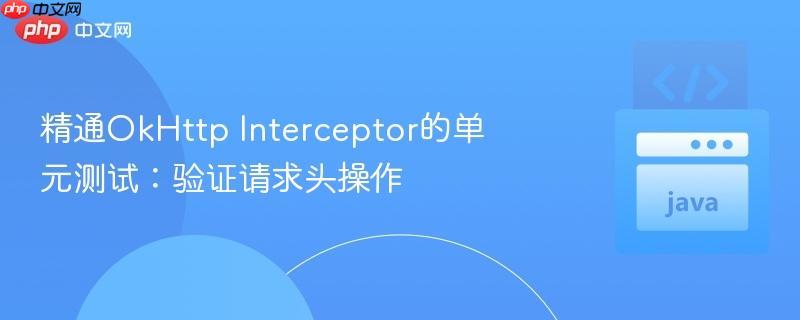
本文深入探讨了如何对OkHttp Interceptor进行高效的单元测试,特别是针对修改请求头的场景。文章首先分析了直接测试OkHttpClient实例的局限性,随后详细介绍了利用Spock框架和Mock技术,通过模拟Interceptor.Chain来隔离测试Interceptor的核心逻辑,并验证其对请求头所做的修改。示例代码和详细解析将帮助读者掌握正确的测试策略。
OkHttp Interceptor是处理网络请求和响应的关键组件,它允许我们在请求发出前修改请求(如添加认证头),或在响应返回后处理响应。例如,一个常见的Interceptor会为所有出站请求添加一个Authorization头:
package de.scrum_master.stackoverflow.q74575745;
import okhttp3.Interceptor;
import okhttp3.Request;
import okhttp3.Response;
import java.io.IOException;
class AuthRequestInterceptor implements Interceptor {
@Override
public Response intercept(Interceptor.Chain chain) throws IOException {
Request original = chain.request();
// 请求定制:添加请求头
Request.Builder requestBuilder = original.newBuilder()
.header("Authorization", "auth-value");
Request request = requestBuilder.build();
return chain.proceed(request); // 继续处理修改后的请求
}
}在单元测试这类Interceptor时,核心挑战在于如何验证Interceptor确实修改了“出站”的Request对象。传统的测试方法可能倾向于构建一个完整的OkHttpClient实例,然后发起一个请求,最后尝试从Response对象中检查请求头。然而,这种方法存在根本性问题:Response对象只包含服务器返回的响应头,而无法直接访问Interceptor修改后发送出去的Request对象的请求头。
考虑以下错误的测试尝试:
// 错误的测试方法示例
class AuthRequestInterceptorTest extends Specification {
AuthRequestInterceptor authRequestInterceptor = new AuthRequestInterceptor();
OkHttpClient okHttpClient; // 假设这里已正确初始化
void setup() {
// ... 初始化 okHttpClient 并添加 authRequestInterceptor ...
}
def "Get Authorization in to header"() {
given:
// 准备一个不带Authorization头的初始请求
Request mockRequest = new Request.Builder()
.url("http://1.1.1.1/heath-check")
.build()
when:
// 通过完整的OkHttpClient发起请求
Response res = okHttpClient.newCall(mockRequest).execute()
then:
// 尝试从响应中获取Authorization头,这会失败
res.headers("Authorization") // 这将返回空或服务器返回的Authorization头,而不是Interceptor添加的
}
}上述测试失败的原因是,res.headers("Authorization")获取的是服务器响应中的Authorization头,而不是Interceptor在客户端添加并发送出去的请求头。为了正确地测试Interceptor对请求头的修改,我们需要一种更隔离、更直接的方法。
为了有效地单元测试AuthRequestInterceptor,我们应该将其与外部网络环境和OkHttpClient实例解耦。核心思想是模拟Interceptor.Chain接口,因为它是Interceptor与整个请求处理链交互的唯一途径。通过模拟Chain,我们可以控制Interceptor接收到的原始请求,并验证它将修改后的请求传递给了chain.proceed()方法。
Spock是一个强大的Groovy测试框架,非常适合进行这种类型的Mock和验证。以下是使用Spock对AuthRequestInterceptor进行单元测试的示例:
package de.scrum_master.stackoverflow.q74575745
import okhttp3.Interceptor
import okhttp3.Request
import spock.lang.Specification
class AuthRequestInterceptorTest extends Specification {
def "request contains authorization header"() {
given: "a mock interceptor chain returning a prepared request without headers"
def chain = Mock(Interceptor.Chain) {
// 配置Mock,当调用chain.request()时,返回一个不带Authorization头的原始请求
request() >> new Request.Builder()
.url("http://1.1.1.1/heath-check")
.build()
}
when: "running the interceptor under test"
// 执行Interceptor的intercept方法,它会接收到模拟的原始请求并对其进行修改
new AuthRequestInterceptor().intercept(chain)
then: "the expected authorization header is added to the request before proceeding"
// 验证chain.proceed()方法被调用了1次
// 并且传入的Request参数满足特定的条件:其Authorization头包含"auth-value"
1 * chain.proceed({ Request request -> request.headers("Authorization") == ["auth-value"] })
}
}given: "a mock interceptor chain returning a prepared request without headers"
when: "running the interceptor under test"
then: "the expected authorization header is added to the request before proceeding"
这种方法将AuthRequestInterceptor完全隔离,只关注其核心逻辑:接收一个请求,修改它,然后将修改后的请求传递给链中的下一个组件。它避免了网络请求、服务器响应等外部因素的干扰,使得测试更加快速、可靠且易于维护。
通过采用上述策略,您可以为您的OkHttp Interceptor编写健壮、高效的单元测试,确保它们在不依赖外部环境的情况下按预期工作。
以上就是精通OkHttp Interceptor的单元测试:验证请求头操作的详细内容,更多请关注php中文网其它相关文章!

每个人都需要一台速度更快、更稳定的 PC。随着时间的推移,垃圾文件、旧注册表数据和不必要的后台进程会占用资源并降低性能。幸运的是,许多工具可以让 Windows 保持平稳运行。

Copyright 2014-2025 https://www.php.cn/ All Rights Reserved | php.cn | 湘ICP备2023035733号